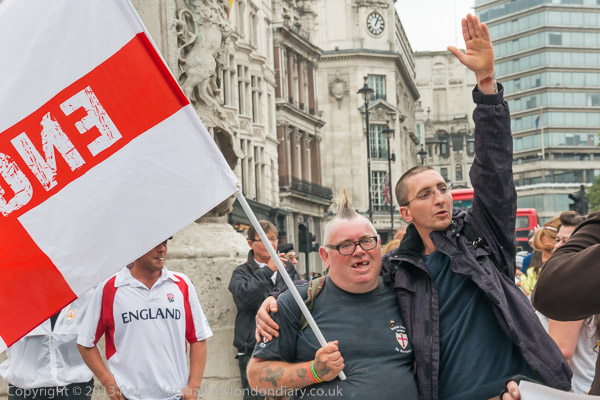
These two men were posing for a photograph in Trafalgar Square, not posing for me, though I’d photographed the man on the left several times earlier, but for a picture being taken by a man with a phone – I think the elbow seen at the right of image is his. The man in the centre is looking at me and may be aware that I’m taking a photograph, though I’m a short distance away using the 18-105mm at 62mm (93mm equiv). He is wearing an EDL sweatshirt, with its motto ‘No Surrender’ and holding an England flag. He probably isn’t aware of the raised hand salute the man with an arm around his shoulder is making for a photograph. Its something most who come to EDL marches have learnt to avoid, preferring to raise two fingers, as you can see in the image below, taken a second later with the same lens in wide-angle, but there are almost always a few who stick to the old ways.
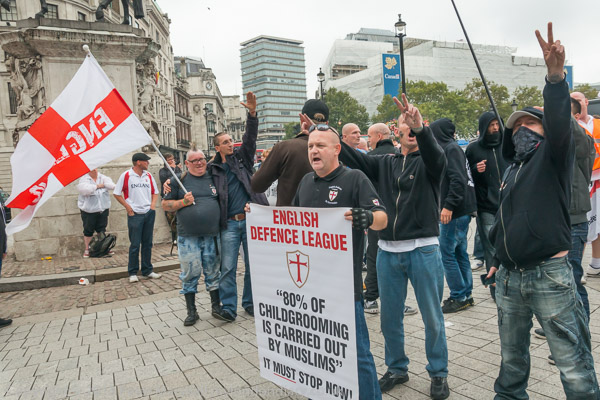
The EDL have often accused photographers of misrepresenting such gestures, of catching someone waving to his friends. Here I think it is clear that this is not the case. It wasn’t the only such gesture that I saw during the event, but was certainly atypical. And gestures are often easily misinterpreted.
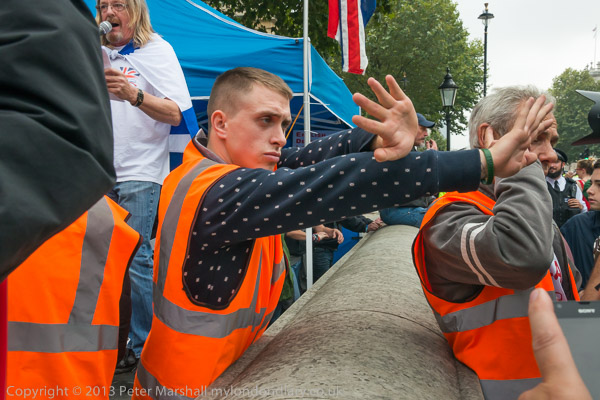
This was one that perhaps left little room for misinterpretation, with one of the EDL stewards holding both palms in front of the lens of another photographer who like me was attempting to photograph the public rally that came after the short march. Again taken with the D800E and 28-105mm, at 26mm (39mm eq) and perhaps just cropped a little too tightly in camera. with the top of the speaker’s head cropped at upper left, and the lens hood just not quite pushing far enough into the image. Perhaps it could also be made a little clearer in post-processing. Like around 99% of the images I use this is the un-cropped frame – I try hard to crop in camera and sometimes perhaps do so too tightly.
I don’t know why the steward felt he wanted to stop one of my fellow journalists photographing the event. There might well have been a good reason for trying to stop anyone recording the speaker, but I suspect the EDL will themselves have put videos of his speech on the web.
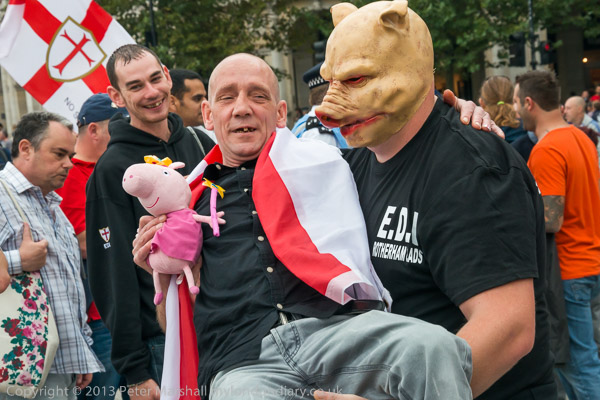
The EDL did seem to be making an effort to improve their image. Early in the day I’d heard a steward tell someone to put their can of beer away when he started drinking in the pen opposite Downing St, and there was certainly less drinking than at earlier events. The meeting point for the march wasn’t this time at a pub, but in the traffic island at Trafalgar Square with Charles I on his horse. And although some groups were drinking, most people were simply standing around and talking. Some posed for photographers and others were happy to be photographed. I had a few polite conversations, including some with people who recognised me from earlier events (and hostile comments on the web) and was able to wander freely without harassment.
Again the man carrying the pink pig was posing for a friend of his to take a picture, being held by the man in the E.D.K. Rotherham Lads shirt and pig’s head mask. I was a little too far away to get the picture exactly how I would have like, and by the time I had moved closer the picture had gone. Again I perhaps could have framed a little less tightly, but I didn’t have a clear view. I did take some other pictures of the man in the mask a minute or two later, some with a wide-angle, which are graphically stronger, but perhaps this one is a more truthful images of the event.
There are always dilemmas. Does producing strong images glorify the activities of the EDL? Do photographers inevitable sensationalise groups like this? Do we always pick on the atypical but photogenic?
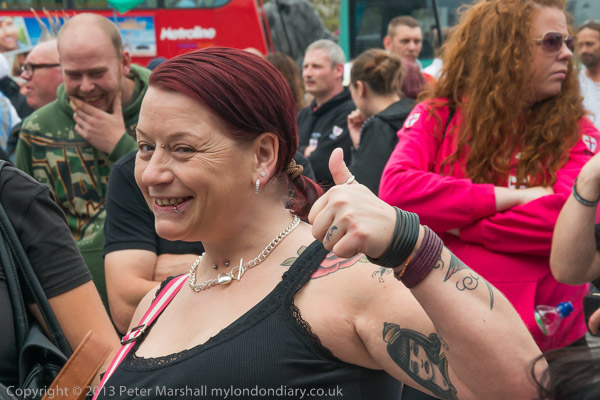
Of course we have to dramatise, to make pictures which will interest the viewer – or else no one is going to look at them event when they do get published. And while I may disagree with the politics of the EDL and other extreme right groups, they do include some visually interesting individuals. But I try hard not just to photograph these people but to show the events in the round, to tell the story through my pictures.
Back in the days when reproducing images was difficult and expensive there was perhaps some justification for the way that newspapers handled images, with those that used photographs (and some of the more serious press didn’t) generally picking a single image. Magazines would perhaps use a few, but even with the ‘illustrated magazines’ they were seen as subservient to the text.
Economics and production have changed, both in print and of course on the web, but the major media still largely stick to the old mould. Where they have embraced images it has largely been as video. Some publications will occasionally add an ‘image gallery’. But I can think of no major publication that has ever seriously engaged with Moholy-Nagy’s 1930s statement ‘The illiterate of the future will be ignorant of the use of the camera and pen alike’.
I’m not sure what the results of taking this seriously would be, though of course there were some attempts in those illustrated magazines, both back in the 1930s and since. Occasionally there are article which effectively mix text with pictures on the web, but not I think that really go far enough.
My own My London Diary for practical reasons largely separates images and text – site design and time constraints don’t allow me to go further in this direction. It’s also not possible for one person to effectively cover almost any event both as a photographer and as a writer; the two require different approaches. Combining videography with writing is rather easier, as the video provides a continuous stream which records the event, while the still photographer has to concentrate on moments. And for us the sounds and speeches are often a distraction while for the writer they are essential. A video camera can act as a notebook for the writer (particularly those ignorant of shorthand) in a way a still camera cannot.
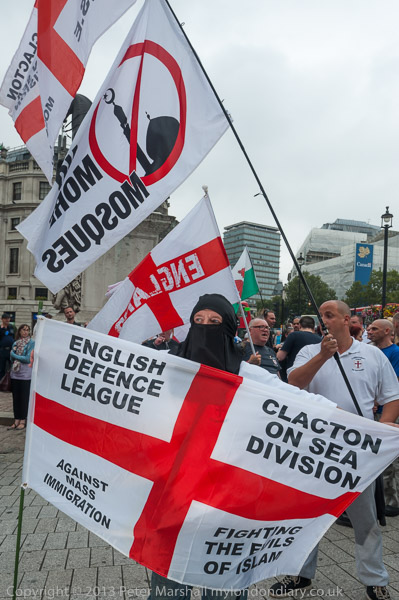
Giving journalists a camera and sending them to events to write and photograph is to sideline photography, and some of the results that we have seen show this clearly. But it is also true that the media have seldom managed to use images effectively. And perhaps photographers have played some part in this, with the willingness to play along with the clichés, often in the name of professionalism, particularly in the UK.
Any publication that tried to do so would of course be accused of ‘dumbing down’ in our logocentric culture, but there is no reason why this should be the case. Images can add to understanding and appreciation of events without in any way compromising the written text, while the current emphasis on getting writers to take photographs will undoubtedly damage their writing.
And were publications to serious use photographs, both online and in print, they might just become more popular, reaching a wider audience. Which would be good news, and even perhaps reverse the current financial bankruptcy of photographers, as repro fees continue to plunge. If the papers used ten of my pictures in place of one to help them tell the story effectively it would just about compensate for the lower rates compared to twenty years ago.
______________________________________________________
My London Diary : Buildings of London : River Lea/Lee Valley : London’s Industrial Heritage
All photographs on this and my other sites, unless otherwise stated, are taken by and copyright of Peter Marshall, and are available for reproduction or can be bought as prints.
To order prints or reproduce images
________________________________________________________